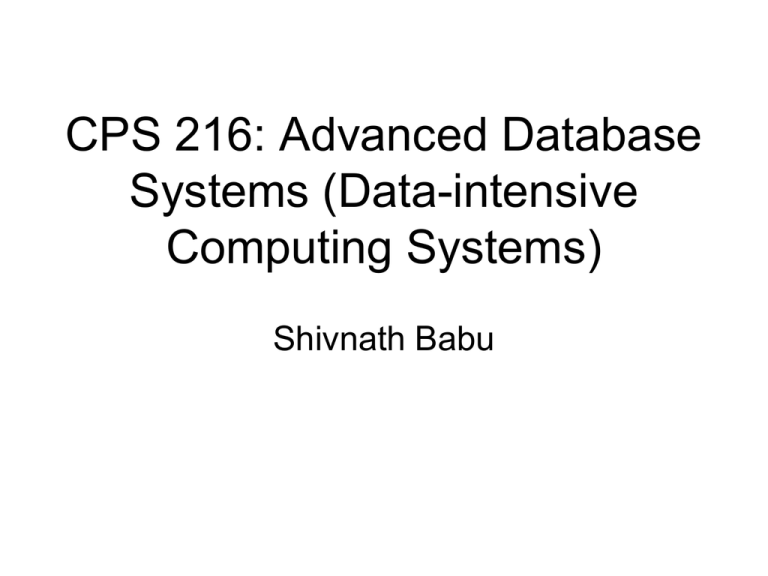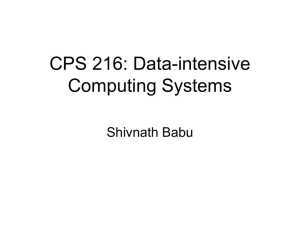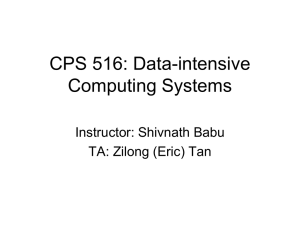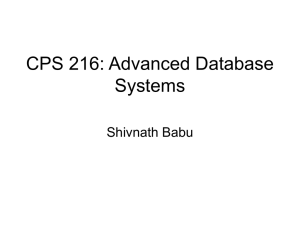CPS 216: Advanced Database Systems (Data-intensive Computing Systems) Shivnath Babu
advertisement

CPS 216: Advanced Database Systems (Data-intensive Computing Systems) Shivnath Babu A Brief History Relational database management systems Time 19751985 19851995 19952005 20052010 2020 Let us first see what a relational database system is User/Application Data Management Query Query Query Data DataBase Management System (DBMS) Example: At a Company Query 1: Is there an employee named “Nemo”? Query 2: What is “Nemo’s” salary? Query 3: How many departments are there in the company? Query 4: What is the name of “Nemo’s” department? Query 5: How many employees are there in the “Accounts” department? Employee Department ID Name DeptID Salary … ID Name … 10 Nemo 12 120K … 12 IT … 20 Dory 156 79K … 34 Accounts … 40 Gill 89 76K … 89 HR … 52 Ray 34 85K … 156 Marketing … … … … … … … … … DataBase Management System (DBMS) High-level Query Q Answer DBMS Data Translates Q into best execution plan for current conditions, runs plan Example: Store that Sells Cars Make Model OwnerID ID Name Owners of Honda Accords Honda Accord 12 12 Nemo who are <= Honda Accord 156 156 Dory 23 years old Join (Cars.OwnerID = Owners.ID) Filter (Make = Honda and Model = Accord) Cars Age 22 21 Filter (Age <= 23) Owners Make Model OwnerID ID Name Age Honda Accord 12 12 Nemo 22 Toyota Camry 34 34 Ray 42 Mini Cooper 89 89 Gill 36 Honda Accord 156 156 Dory 21 … … … … … … DataBase Management System (DBMS) High-level Query Q Answer DBMS Keeps data safe and correct despite failures, concurrent updates, online processing, etc. Data Translates Q into best execution plan for current conditions, runs plan A Brief History Relational database management systems Time 19751985 19851995 Assumptions and requirements changed over time Semi-structured and unstructured data (Web) Hardware developments 19952005 20052010 2020 Developments in system software Changes in data sizes Big Data: How much data? Google processes 20 PB a day (2008) Wayback Machine has 3 PB + 100 TB/month (3/2009) eBay has 6.5 PB of user data + 50 TB/day (5/2009) Facebook has 36 PB of user data + 80-90 TB/day (6/2010) CERN’s LHC: 15 PB a year (any day now) LSST: 6-10 PB a year (~2015) 640K ought to be enough for anybody. From http://www.umiacs.umd.edu/~jimmylin/ From: http://www.cs.duke.edu/smdb10/ NEW REALITIES The quest for knowledge used to TBwith disks < $100 begin grand theories. Everything is data Now it begins with massive amounts Rise of data-driven culture of data. Very publicly espoused Welcome to theWired, Petabyte by Google, etc.Age. Sloan Digital Sky Survey, Terraserver, etc. From: http://db.cs.berkeley.edu/jmh/ THE NEW PRACTITIONERS “Looking for a career where your services will be in high demand? … Provide a scarce, complementary service to something that is getting ubiquitous and cheap. the sexy job in the next ten years will be statisticians So what’s ubiquitous and cheap? Data. And what is complementary to data? Analysis. Hal Varian, UC Berkeley, Chief Economist @ Google From: http://db.cs.berkeley.edu/jmh/ THE NEW PRACTITIONERS Aggressively Datavorous Statistically savvy Diverse in training, tools From: http://db.cs.berkeley.edu/jmh/ FOX AUDIENCE NETWORK • Greenplum parallel DB • 42 Sun X4500s (“Thumper”) each with: • • • 48 500GB drives • 16GB RAM • 2 dual-core Opterons Big and growing • 200 TB data (mirrored) Fact table of 1.5 trillion rows Growing 5TB per day • • • 4-7 Billion rows per day From: http://db.cs.berkeley.edu/jmh/ Also extensive use of R and Hadoop Yahoo! runs a 4000 node Hadoop cluster (probably the largest). Overall, there are 38,000 nodes running Hadoop at Yahoo! As reported by FAN, Feb, 2009 A SCENARIO FROM FAN How many female WWF fans under the age of 30 visited the Toyota community over the last 4 days and saw a Class A ad? How are these people similar to those that visited Nissan? Open-ended question about statistical densities (distributions) From: http://db.cs.berkeley.edu/jmh/ MULTILINGUAL DEVELOPMENT SQL or MapReduce Sequential code in a variety of languages Perl Python Java R Mix and Match! From: http://db.cs.berkeley.edu/jmh/ From: http://outsideinnovation.blogs.com/pseybold/2009/03/-sun-will-shine-in-blue-cloud.html Teaching/Learning Methodology Relational database management systems Time 19751985 19851995 Assumptions and requirements changed over time Semi-structured and unstructured data (Web) Hardware developments 19952005 20052010 2020 Developments in system software Changes in data sizes Course Outline • Principles of query processing (30%) – Indexes – Query execution plans and operators – Query optimization • Data storage (10%) – Databases Vs. filesystems (Google/Hadoop Distributed FileSystem) – Flash memory and Solid State Drives • Scalable data processing (35%) – Parallel query plans and operators – Systems based on MapReduce – Scalable key-value stores • Concurrency control and recovery (15%) – Consistency models for data (ACID, BASE, Serializability) – Write-ahead logging • Information retrieval and Data mining (10%) – Web search (Google PageRank, inverted indexes) – Association rules and clustering Course Logistics • Web: http://www.cs.duke.edu/courses/fall10/cps216 • TA: Gang Luo • References: – Hadoop: The Definitive Guide, by Tom White – Database Systems: The Complete Book, by H. GarciaMolina, J. D. Ullman, and J. Widom • Grading: – Project 35% (Hopefully, on Amazon Cloud!) – Homework Assignments 15% – Midterm 25% – Final 25%






